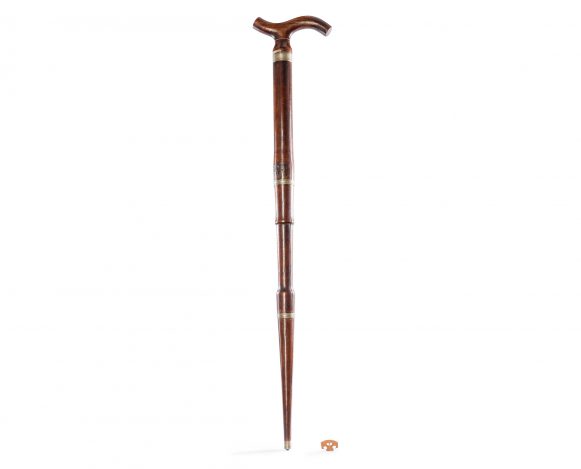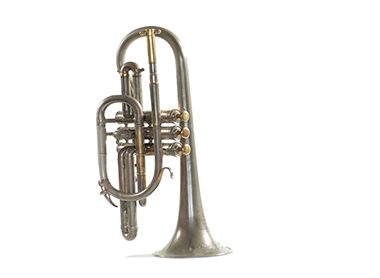



The instrument was built in a cane, it is a kind of cane-violin. The front part (tailpiece, fingerboard, tuning pegs, bridge and soundboard) is below the upper half of the cane, made of a piece of removable wood. The upper end of the cane is also removable and has a metal ring that fits into another metal part located in the resonance box itself. The tuning pegs were replaced by pins, which, in this sort of instrument, are adjusted with a key. The bow is kept inside the hollow of the cane, that is, inside the resonance box. In order to play, the musician rests the instrument on his chest and touches the strings with the bow, held by the right hand, while the left hand performs the strumming on the neck of the instrument. The Museum’s specimen does not have a tuning key.
The cane violin is the result of a merger between a violin and a cane. The French term “promenade” means walk and shows that the instrument was built to be a portable violin, easy to transport, as well as a cane. During the 19th century, in Europe, the objects that were the result of the merger of other objects – such as a weapon, an umbrella – with a cane, were common. This trend also influenced the making of musical instruments and various of them, especially violins, flutes and clarinets, were built in this format. Although the making of “instrument-canes” occur since the Renaissance, Romanticism was the period when this practice reached its peak. In Europe, at that time, there was a great interest in novelties, as well as wealth and free time for the making and use of luxury goods. As the sound of these instruments was very limited, most of the time its use was made by amateurs who were interested in music outdoors. Cane violins like the Museum’s specimen continued to be produced in Germany until the turn of the 20th century.
BASE MINERVA, 2014.
BETHENCOURT; BORDAS; CANO; CARVAJAL; SOUZA; DIAS; LUENGO; PALACIUS; PIQUER, ROCHA, RODRIGUEZ; RUBIALES; RUIZ, 2012.
BRAGA, 1973.
BRANDÃO, 2013.
CARVALHO, 1905.
GROVE MUSIC ONLINE, 2014.
MATTOS, 2012.
MIMO, 2014.
ROLLA, 1974.
SOARES, 1990.








